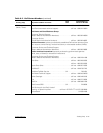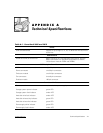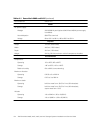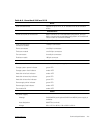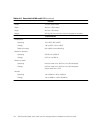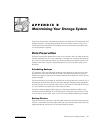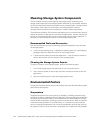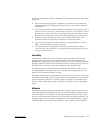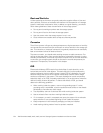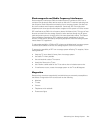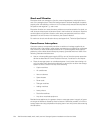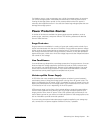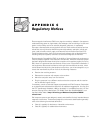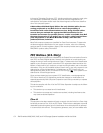
support.dell.com Maintaining Your Storage System B-3
To minimize the negative effects of temperature on system performance, follow these
guidelines:
Ensure that the storage system is operated in an environment no colder than
10 degrees Celsius (C) (50 degrees Fahrenheit [F]) or hotter than 35 degrees C
(95 degrees F).
Ensure that the storage system has adequate ventilation. Do not place it within a
closed-in wall unit or on top of cloth material, which can act as insulation. Do not
place it where it will receive direct sunlight, particularly in the afternoon. Do not
place it next to a heat source of any kind, including heating vents during winter.
Make sure that all slots and openings on the storage system remain unob-
structed, especially the fan guard on the back of the storage system.
Clean the storage system at regular intervals to avoid any buildup of dust and
debris, which can cause a system to overheat.
If the storage system is exposed to abnormally cold temperatures, allow a
15-minute warm-up period after it is turned on before attempting to read from or
write to the hard-disk drive.
+XPLGLW\
High-humidity conditions can cause moisture migration and penetration into the
storage system. This moisture can cause corrosion of internal components and
degradation of properties such as electrical resistance, thermal conductivity, physical
strength, and size. Extreme moisture buildup inside the storage system can result in
electrical shorts, which can cause serious damage to the storage system.
The storage system is rated to operate at 8 to 80 percent relative humidity, with a
humidity gradation of 10 percent per hour. In storage, the storage system can with-
stand from 8 to 95 percent relative humidity.
Buildings in which climate is controlled by air-conditioning in the warmer months and
by heat during the colder months usually maintain an acceptable level of humidity for
system equipment. However, if a storage system is located in an unusually humid
location, a dehumidifier can be used to maintain the humidity within an acceptable
range.
$OWLWXGH
Operating a storage system at high altitude (low pressure) reduces the efficiency of
forced and convection cooling and can result in electrical problems related to arcing
and corona effects. This condition can also cause sealed components with internal
pressure, such as electrolytic capacitors, to fail or perform at reduced efficiency. The
storage system is rated to operate at altitudes from –16 to 3048 meters (m) (–50 to
10,000 feet [ft]) and can be stored at altitudes of –16 to 10,600 m (–50 to 35,000 ft).



